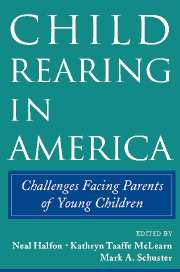Book contents
- Frontmatter
- Contents
- Tables
- Figures
- Contributors
- Acknowledgments
- 1 Introduction and Overview
- PART I CONDITIONS OF FAMILIES WITH YOUNG CHILDREN
- PART II CHILD-REARING PRACTICES
- PART III DELIVERY OF HEALTH SERVICES TO MOTHERS AND CHILDREN
- 9 Prenatal Care, Delivery, and Birth Outcomes
- 10 Access to Health Care for Young Children in the United States
- 11 Anticipatory Guidance: What Information Do Parents Receive? What Information Do They Want?
- PART IV FUTURE DIRECTIONS AND POLICY IMPLICATIONS
- Index
- References
9 - Prenatal Care, Delivery, and Birth Outcomes
Published online by Cambridge University Press: 15 July 2009
- Frontmatter
- Contents
- Tables
- Figures
- Contributors
- Acknowledgments
- 1 Introduction and Overview
- PART I CONDITIONS OF FAMILIES WITH YOUNG CHILDREN
- PART II CHILD-REARING PRACTICES
- PART III DELIVERY OF HEALTH SERVICES TO MOTHERS AND CHILDREN
- 9 Prenatal Care, Delivery, and Birth Outcomes
- 10 Access to Health Care for Young Children in the United States
- 11 Anticipatory Guidance: What Information Do Parents Receive? What Information Do They Want?
- PART IV FUTURE DIRECTIONS AND POLICY IMPLICATIONS
- Index
- References
Summary
Childbirth, throughout history, has been shaped by the dual influences of technical expertise and the societal commitment to the promise of life. Current patterns of childbirth in America have been deeply affected by unprecedented innovations in clinical capability to prevent and treat many of the most important traditional threats to the health of women and newborns during pregnancy, labor and delivery, and early infancy. Improvements in preconceptual screening, preventive nutritional supplementation, prenatal diagnosis and intervention, management of high-risk labor and delivery, treatment of critically ill newborns, and integration of preventive educational and social services into primary family health services have all contributed to major changes in both the nature and the risks of childbirth in the United States.
Yet the evolution of childbirth in America is not only a product of technical progress; it is also a reflection of changes in American society and family life. This chapter outlines some of the more important emerging patterns of service utilization and health outcomes related to childbirth in the United States, with a focus on how technical capabilities interact with social forces and how services and outcomes are actually distributed in an increasingly diverse and socially stratified population. Findings from the Commonwealth Fund Survey of Parents with Young Children are then discussed as they reflect on several important areas: prenatal care, attendance at childbirth classes, type of delivery, prematurity and low birthweight, and length of postpartum hospital stay. The chapter ends with a discussion of policy implications and other conclusions.
- Type
- Chapter
- Information
- Child Rearing in AmericaChallenges Facing Parents with Young Children, pp. 263 - 292Publisher: Cambridge University PressPrint publication year: 2002



